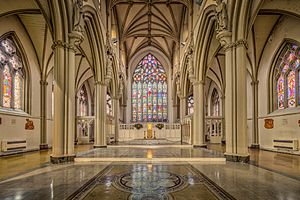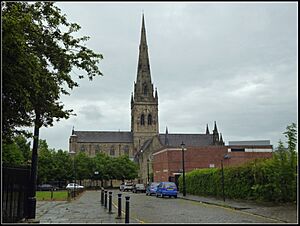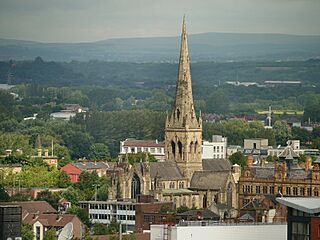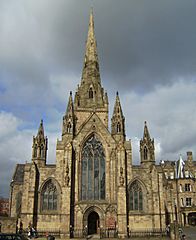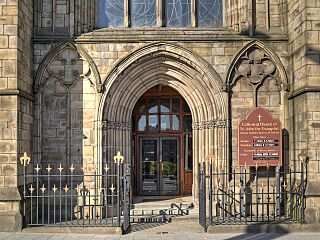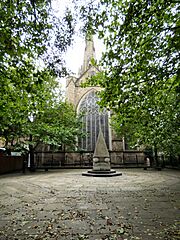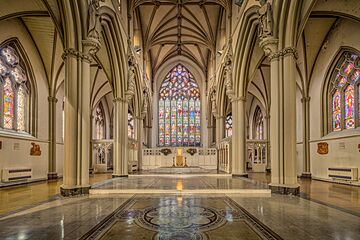Salford Cathedral facts for kids
Quick facts for kids Salford Cathedral |
|
|---|---|
| Cathedral Church of St. John the Evangelist | |
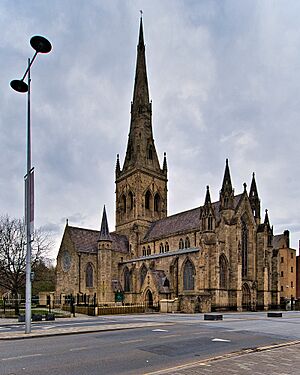
Exterior of Salford Cathedral
|
|
| 53°29′01″N 2°15′40″W / 53.4836°N 2.2610°W | |
| OS grid reference | grid reference SJ82769857 |
| Location | Salford, Greater Manchester |
| Country | England |
| Denomination | Catholic |
| Tradition | Catholic |
| Membership | Catholic |
| Website | [1] |
| History | |
| Status | Active |
| Consecrated | 1890 |
| Architecture | |
| Functional status | Active |
| Heritage designation | Grade II* listed |
| Architect(s) | Matthew Ellison Hadfield |
| Style | Gothic Revival and neo-Gothic |
| Years built | 1844–48 |
| Specifications | |
| Number of spires | 1 |
| Spire height | 73.2 m (240 ft) |
| Administration | |
| Deanery | Salford |
| Diocese | Salford (since 1850) |
| Province | Liverpool (since 1911) |
The Cathedral Church of St. John the Evangelist, often called Salford Cathedral, is a beautiful Catholic church in Salford, Greater Manchester, England. It is the main church for the Bishop of Salford and the most important church in the Diocese of Salford. This historic building is also listed as a Grade II* building, meaning it is very special and protected.
Contents
History of Salford Cathedral
Salford Cathedral, originally known as St. John's Church, was built between 1844 and 1848. The design was created by Matthew Ellison Hadfield, an architect from Sheffield. Benjamin Hollins of Manchester was the builder.
Hadfield's design for St. John's was very special. It was the first Catholic church in England built in a cruciform (cross-shaped) style since the Reformation. This was a time when the Church in England changed a lot.
The church's design was inspired by several old medieval churches. For example, the front part and the main hall (nave) look like a smaller version of Howden Minster. The back part where the choir sings (choir and sanctuary) is similar to Selby Abbey. The fancy decorations on the arched ceilings (groined vault) were copied from a church in Liège, Belgium. The tall tower and spire, which was the tallest in Lancashire when it was built, were inspired by the church of St Mary Magdalene in Newark-on-Trent.
Funding and Early Features
Two local businessmen, Daniel Lee and John Leeming, each gave £1,000 to help pay for the church and its decorations. They are remembered in special chapels inside the church.
The large "east" window, made in 1856 by William Wailes, tells the story of Catholic Christianity in England. It shows important moments, from the conversion of King Ethelbert in 597 to the re-establishment of the Catholic Church in England in 1850. The total cost to build the cathedral was £18,000.
Becoming a Cathedral
The first stone of the church was laid in 1844 by Bishop James Sharples. The church officially opened on August 9, 1848, with a special Mass attended by many bishops.
St. John's became a cathedral in 1852. This happened after the Diocese of Salford was created in September 1850. It was one of the first four Catholic cathedrals in England and Wales since the English Reformation. On July 25, 1851, William Turner became the first Bishop of Salford in St. John's.
Repairs and Renovations
In October 1881, a strong storm badly damaged the cathedral's 73.2-meter (240 ft) spire. Canon Beesley helped raise money to fix the spire and repair the building. He also oversaw the creation of a new chapel in 1884, designed by Peter Paul Pugin.
By early 1890, the last £1,000 of the original building debt was paid off. This allowed the cathedral to be officially consecrated (made sacred) in the same year by the second Bishop of Salford, Herbert Vaughan.
In 1919–20, the small towers on the front of the cathedral were in danger of falling. They were taken down and rebuilt by O'Neill & Son, guided by Charles M. Hadfield, the grandson of the original architect. In 1924, a special chapel was opened to remember those who died in World War I.
By 1934, the cathedral's spire was leaning, so about 18 meters (60 feet) of it had to be removed. Repairs were finished in 1938. After World War II, more repairs were done to fix damage from the war.
More restoration work happened in 1971–72, costing £80,000. This included adding a new altar under the main crossing, following changes from the Second Vatican Council. In 1988, the choir area was changed again. The original stone altar and screen, installed in 1853–55, were removed.
A new stained-glass window was put in the west side of the cathedral in 1994. It celebrated 150 years since the first stone was laid. The window shows a modern image of Christ on the cross, with the Virgin Mary and St. John.
In spring 2007, the outside stonework of the spire and front of the cathedral was repaired. More major repairs to the roof and stone walls were done in 2018 to stop leaks.
In November 2021, Salford Cathedral was closed for a big restoration project. This project, which was set to finish by 2024, included putting back some of the cathedral's original Victorian features that were removed in the 1970s. A new roof was also added to the building.
The Cathedral Organ
A new digital organ with four keyboards was installed in 2002. While digital organs are not common in cathedrals, this one is very good. It has many different sounds and is better than the old one. Its speakers are placed high up in the windows to help the choir and people singing.
The current organ replaced an older pipe organ from 1951. Before that, there was an experimental organ from 1938. The earliest organ recorded in the cathedral was installed in 1887.
Gallery
See also
 In Spanish: Catedral de San Juan Evangelista (Salford) para niños
In Spanish: Catedral de San Juan Evangelista (Salford) para niños
- Grade II* listed buildings in Greater Manchester
- Listed buildings in Salford, Greater Manchester
- List of tallest buildings and structures in Salford



